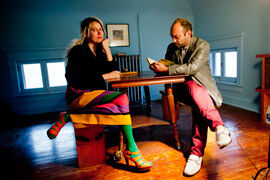
Shifting Focus

by Evangeline Politis (MA 2013)
Chelsea Culp (BFA 2007) and Ben Foch (SAIC 1995–99) are showing their first collaborative work since their curatorial project, New Capital, in two Chicago Artists Month (CAM) exhibitions, The Installation Experiment organized by Sculpture International and presented in seven storefront galleries on Halsted Street, and Home: Public or Private? at 6018 North.
With the December 12 closing of their artist-run project space, New Capital, located in East Garfield Park, Culp and Foch are using their role as featured artists in CAM as a platform to return their collaborative focus to presenting their art work, while still acting as a curatorial team in other venues.
“We wanted to be very distinct about [this work],” Culp explains. “While we’re introducing these curatorial ideas into our collaborative work, New Capital will stand as an autonomous artistic curatorial project.”
“It’s kind of like a band where you have your solo project—you have your two-person project, and then you have your band,” Foch analogizes.
The two were honored to introduce their two-person project under the auspices of CAM. Barbara Hashimoto, one of The Installation Experiment organizers and exhibitors, approached the couple after reviewing dozens of submissions.
“The other five artists in The Installation Experiment are interesting artists that wouldn’t usually be curated together,” says Culp. “It was really cool to be a part of it with them because they are making exciting work.”
Hashimoto was hoping to create a representative show, picking artists of different ages and genres from neighborhoods all over the city—supporting this year’s CAM theme, Art Block by Block, which explores the impact of Chicago-based artists on the city’s neighborhoods.
Culp and Foch represent the East Garfield Park community where Foch has kept a studio for the past 11 years and where the two-year-old gallery stands. They both have witnessed some changes there due to the growing artist population.
“I think in some ways artists have annexed this block within East Garfield Park,” Foch explains. “There are now street signs, pavement, street cleaning, trees, and it’s a much safer block now. But I don’t know how much it had impacted the East Garfield Park community at large.”
“It’s done more for artists than it has for the community,” Culp chimes in. “I’m not sure how much being part of what some might call ‘the first wave of gentrification’ really improves the immediate community. In some ways it threatens it. The most honest response to the question of how we improve our community is, ‘I’m not sure if we do.’”
Soon the New Capital chapter of their lives will be closing. They set up the “project,” as they have coined it, with many parameters, including a two-year timeline. They felt they couldn’t commit to something longer than that during this time of flux in their careers, but, on the other hand, could still build momentum, relationships, and cachet in the timespan of 24 months.
“When there’s enough time for something to happen more than once, you can really come to know it,” says Culp. “I have a better understanding of what motivates someone to make and exhibit work, including myself.”
Foch and Culp have been able to observe how artists produce and distribute work and used New Capital as litmus for the cultural climate both locally and nationally. This has pushed them toward their plans after the gallery: they will produce a catalog documenting the gallery’s run, produce and exhibit their collaborative works, and visit other artist-run exhibition projects around the world, including the Sober and Lonely Institute for Contemporary Art in Johannesburg, South Africa (the equivalent of a project like New Capital there, they explained). “We really want to be a little mobile and experience this independent production in other places. We want to know the values and issues of other artists,” Culp explains.
The two describe their SAIC education as supporting the success of their grass-roots gallery. Foch, who studied in the Painting department, and Culp, who studied studio and Art History, Theory, and Criticism, both remember nothing being off limits—no discipline or project. In navigating how to run their own gallery, they started by setting their own objectives and parameters, a skill they learned in the open environment at the school.
“At school, people really encouraged you to pursue whatever you’re interested in,” she explains. “At the time, I found that really stressful because there wasn’t any direction. But for better or worse, the way that plays out is like the real world. There is no definite path to find out what you’re supposed to be doing; you just have to decide what you want to do and figure out how to do it.”
